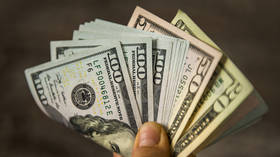Fed announces highest interest rate hike since 2000

Citing high inflation, the US Federal Reserve has raised its base interest rate by 50 basis points, or 0.5%, and announced it would be selling off some assets from its $9 trillion balance sheet. The rate hike is the highest since May 2000, when the dot-com stock bubble burst.
“Inflation is much too high,” Fed chair Jerome Powell said on Wednesday afternoon, adding that “we have both the tools we need and the resolve it will take to bring it down.”
However, Powell noted, the Fed’s policies can only impact the demand side of things and not supply disruptions, which have been “longer-lasting than anticipated.” He blamed the supply problems on Covid-19 lockdowns in China and the conflict in Ukraine.
The Fed is also “significantly reducing the size of our balance sheet,” mainly by selling securities holdings over time. Starting on June 1, principal payments from securities held in the System Open Market Account (SOMA) will be reinvested if they exceed $30 billion per month. That cap will increase to $60 billion per month by September. For agency debt and mortgage-backed securities, the initial cap will be $17.5 billion per month, doubling to $35 billion after three months. The Fed has an estimated $9 trillion balance sheet.
In April, the US recorded the highest spike in year-over-year inflation since 1981, with a 8.5% increase in the consumer price index. The Fed’s own inflation calculations are lower, since they exclude the “volatile” food and fuel costs.
The rate hike may drive up unemployment in the short term, Powell acknowledged, but said this needed to happen to curb inflation.
“We can’t allow a wage-price spiral to happen,” Powell said, referring to the phenomenon where higher wages drive up prices of goods and services.
“The labor market is extremely tight,” he added, pointing out that there were 11.9 million job vacancies and six million Americans looking for work, almost a 2:1 ratio. He anticipated that the unemployment rate would “nudge” up as more Americans return to the labor force.
“There may be some pain” for Americans as the Fed gets inflation back to 2%, but not dealing with it would be even worse, Powell said, arguing that everyone will be better off in the medium-to-long term.













